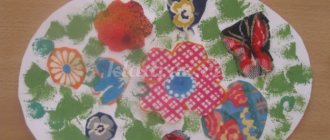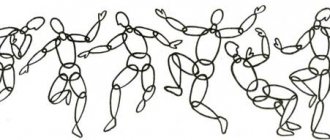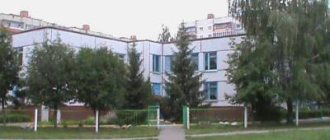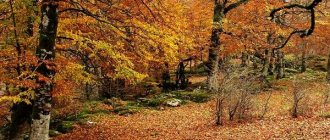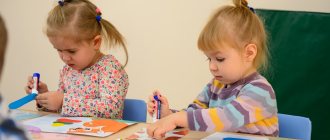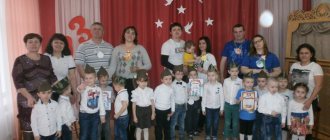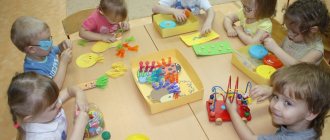Summary of the targeted walk “Winter in the kindergarten area” in the middle group
Summary of the targeted walk “Winter in the kindergarten area” in the middle group
Program content: to develop in children interest and love for their native nature, to introduce them to the first signs of winter, to consolidate the ability to observe natural phenomena and establish the simplest connections between them.
Equipment and materials: food for bird feeders, attributes for outdoor games: Morozov caps and noses.
Progress of the walk Educator. Guys, why is the site completely different today? What is the weather today? How is it different from autumn? (Children's answers.) Listen to the riddle: In the morning I looked at the light: The yard was dressed for winter. I opened the doors wide, I looked into the garden, I couldn’t believe my eyes. Hey! Look, miracles - the heavens have fallen! There was a cloud above us, It turned out to be under our feet. A. Gunali
– What time of year is the riddle about? That's right, guys, about winter. Listen to a poem about winter. White fluffy snow swirls in the air and quietly falls to the ground and lies down. And in the morning the Field turned white with snow, as if everything had covered it with a shroud. The dark forest covered itself with a wonderful hat and fell asleep under it, soundly, soundly... I. Surikov
– It’s a beautiful poem, isn’t it? Let's take a close look at the first white snowflakes, how they spin and slowly fall to the ground. Let's compete to see whose mitten the most snowflakes will fall on! If you catch a snowflake in your palm, what happens? (Children make sure that snowflakes melt quickly). This happens because snow is made of water. In autumn, instead of snow, it rains, and in winter, due to frost, the raindrops freeze and turn into snowflakes. Now try with your palm how does snow feel to the touch? That's right, cold. But for the earth and plants, snow is a real warm blanket. The more snow in winter, the warmer the grasses and shrubs. Snow protects them from severe frosts and snowballs. Let's see how plants sleep under a white fluffy blanket. (The teacher carefully shovels the snow down to the soil and shows the children green blades of grass.) And when spring comes, the snow will melt and the grass will turn green and grow again. Let's go ahead and see what happened to our trees. Do they have leaves on them? (Children's answers.) That's right, guys, the trees are bare, there is not a single leaf. Tell me, is there a tree that does not change its appearance in autumn and winter? One color in winter and summer.
- What is this? That's right, Christmas tree. The street Christmas tree is green all winter, it is not afraid of frost, instead of leaves it has beautiful green needles. Very soon the green Christmas tree will come to us for the holiday. Can you guess which one? That's right, in winter all people celebrate the New Year. Go to the mountain ash and see what happened to it. There are a lot of beautiful, red berries on the rowan tree. In winter, frost makes these berries very tasty. Birds peck them with pleasure. And here is our feeder. Let's put food in it, the birds will fly and thank us for it. Remember why birds need to be fed in winter. (Children's answers). Now let’s play the Russian folk game “Two Frosts.” (The game is first learned in a group). Game “Two Frosts” The teacher, together with the children, chooses two Frosts. Frosts: We are two young brothers, Two Frosts are daring. I am Frost the Red Nose. I am Frost - the blue nose, Which of you will decide to set out on the path? Children (together with the teacher): Frosts don’t matter to us! We are not afraid of the cold! You, Frosts, don’t yawn, catch up with us quickly! The frosts catch up with the children and take them to the Ice House (on the veranda). The game repeats itself. At the end of the walk, the teacher and the children conclude that winter has come, it has become even colder in winter than in autumn. The leaves fell from the trees and snow fell.
Targeted walks and excursions; methodological development of the world around us (middle group) on the topic
Long-term plan of excursions and targeted walks
In the middle group No. 1
September
1 Tour of the kindergarten site. Introduce children to the diversity of the plant world.
2 Targeted walk around the territory of the kindergarten. Let the children understand that the territory of the kindergarten is not limited only to the area where children walk; broaden children's horizons. Activate the vocabulary: territory, flower bed, flower garden. Foster a caring attitude towards nature. Develop labor skills and abilities.
3 Targeted walk to the flower garden.
4 Targeted walk to the preparatory group site. Watch older children play. Cultivate friendly relationships. Develop conversational speech.
October
1 Excursion around the territory of the kindergarten. Develop children's skills, admire the beauty of autumn nature.
2. Targeted walk to the kindergarten park. Expand knowledge about the season - autumn, name the signs of autumn. Consider plants: trees, shrubs, herbs. Note that everything has turned yellow, “Golden Autumn” has arrived
3 Target walk “Feathered Friends”. Consider the birds and their body parts. Activate the words in speech: birds, sparrows, crows, fly, sit, jump, fly over.
4 “Grass-ant”. Note that the grass has withered, late autumn has arrived. Name the characteristic signs of autumn.
November
1 A tour of the streets where the kindergarten is located. Introduce children to the rules of safe behavior on the street. Pay attention to objects (shops, post office, clinic)
2 “We’ll go around the garden.” Consider the kindergarten building. Find group windows. Note that every house has windows, doors and their purpose.
3 “Why are fences needed?” Note with children the purpose of fences, reinforce that you cannot walk behind a fence - life safety.
4 Targeted walk to the music room. Get to know the profession of a music director. He teaches us to sing, dance, play musical instruments, and celebrates holidays. Show musical instruments and play them.
December
1 Excursion to the medical office of the kindergarten. Introduce children to the profession.
2 Target walk to a neighboring site. Introduce neighbors to children. Children's ability to communicate with older children.
3 Target walk “We’ll go around the kindergarten.” Looking at the fallen snow.
4 Target walk “Observation of transport”. Strengthen children's knowledge about types of transport (public, freight, passenger)
January
1 Walking tour. LIFE SAFETY FUNDAMENTALS.
2 Targeted walk to the senior group. Introduce children to the group room of older children. Children's ability to communicate with older children. Orientation in space.
3 Target walk to the snowdrift. Consider the snowdrift that caused it to form (accumulation of snow). Activate the words in speech: snow, blizzard, winter, snowdrift.
4 “Whose trace?” Awaken in children a sense of interest and involvement in everything they see and notice. To develop children’s ability to observe, examine and talk.
February
1 Excursion to the laundry. Introduce the profession.
2 “We will go along the path.” Create a joyful mood about the snowy buildings you see. Activate the words in children's speech: snowman, snowwoman, slide, labyrinth.
3 Target walk to the winter tree. Examine the tree, note that it is bare, there are no leaves, because it is still very cold outside.
4 Target walk “Let’s go around the garden.” Looking at the icicles on the roof. Life safety - why you can’t walk under the roofs of houses and kindergartens, reinforcing safety rules.
March
1 Excursion to the kitchen, introduce the equipment. To introduce the profession and cultivate interest in it.
2 Targeted walk around the site. Expand knowledge about the season - spring. Name the signs of spring (snow melting, the sun is warming up, buds are swelling on the trees, birds are singing like spring).
3 Observation of icicles. See the changes that happen to the icicles, the reasons for the drops. Give signs of spring.
4 "Our birds". Continue observing and examining the birds that have flown to the site.
April
1 Excursion to the birch tree. To consolidate children's knowledge that trees do not die in winter; buds remain on the branches, from which green leaves bloom. Plants need warmth to grow. To develop children’s ability to use examination techniques, to arouse interest in observing trees.
2 “Why are fences needed?” Target walk to the fence. Monitoring passing vehicles. Expand knowledge about types of transport (bus, truck, car). Activate words in children's speech: cabin, body, wheels, steering wheel.
3 Targeted walk around the site. Create a joyful mood. Draw the children's attention to the area, how it has changed. There was a lot of snow, but now it has almost all melted.
4 “Where does the puddle live?” Note why they form in the spring. Why? Encourage statements (melting snow, the sun is warming) Show children a variety of actions with melted snow.
May
1 Excursion around the territory and outside of the kindergarten. To form in children an idea of the diversity of the plant world. Develop the ability to distinguish and name familiar flowering plants. Cultivate a caring attitude towards plants.
2 Target walk to the tree. To develop children’s ability to observe, compare, see a phenomenon in its development, what happened recently, what has happened now. Add the following words to your children's active vocabulary: branch, buds, swollen, young leaves appear.
3 Targeted walk around the site. Examine the first young grass that appears. Expand knowledge about changes in nature.
4 Targeted walk to the garden. Observing the work of adults in the garden. Expand children's knowledge about plants. Show seedlings, seeds. Introduce the words: beds, seedlings, seeds, vegetable garden, watering can.
